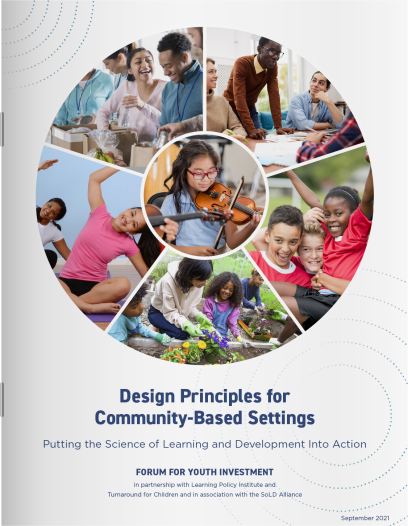In the Fall 2021 issue of American Educator, Pamela Cantor’s article, “All Children Thriving: A New Purpose for Education,” offered a vision, grounded in decades of research and experience, for maximizing the potential of all children in all settings. Much of that article focused on schools, and further details are available in Design Principles for Schools. Here, we provide an excerpt of the companion report, Design Principles for Community-Based Settings, which aims to foster deep collaborations across learning environments—in and out of school buildings.
–EDITORS
Developmental and learning science tell an optimistic story about what all young people are capable of. There is burgeoning scientific knowledge about the biologic systems that govern human life, including the systems of the human brain. Researchers who are studying the brain’s structure, wiring, and metabolism are documenting the deep extent to which brain growth and life experiences are interdependent and malleable. Because researchers know so much more about the brain and development than they did when the 20th-century US education system was designed, we can now use this knowledge to not only redesign that system but affirm a healthy learning and development ecosystem that fully acknowledges the role of families and communities as instrumental places for engaged learning.
As learning is about meaning making—connecting new information and experiences to those that have come before—an awareness of what young people are experiencing in the broader ecosystem is essential. As schools across the country tackle this challenge, they are acknowledging the value of rethinking their role within the ecosystem. The power to transform learning settings and achieve equitable conditions for learning at scale rests on the ability of communities to embrace and deliver integrated, cross-setting approaches to science-aligned transformation. Therefore, Design Principles for Community-Based Settings offers recommendations for promoting a connected and aligned learning ecosystem.
Recommendation 1: Recognize community programs as an essential part of the learning ecosystem. Schools and community partners can co-create a vision of student success that reflects the values and culture of the community’s students and their families and is fully supported by science-aligned approaches. The sheer diversity of community programs means that they do not always present a visible, coordinated force in their communities, yet we know that for many young people, community programs can allow them to thrive. Vision setting requires a shared understanding of where and when learning happens, acknowledging all the settings where young people spend their time, not just classrooms.
Recommendation 2: Prioritize strategic partnerships. Valuing and prioritizing partnerships between schools and community partners requires an intentional outreach and engagement strategy, with resources dedicated to nurturing and maintaining partnerships. Community schools are one approach to aligned partnerships where coordinators facilitate and provide leadership for the collaborative process and development of a continuum of services for children, families, and community members within a school neighborhood.
Recommendation 3: Prioritize and improve coordination throughout the learning ecosystem. National youth-serving organizations with affiliate models, afterschool and summer learning intermediaries, and local children’s cabinets play a critical role in taking science-aligned approaches to scale in communities. Working through their networks, these organizations support professional development, program quality assessment, and effective use of data. Further, local coordination of community programs paves the way for school-community partnerships. However, this kind of coordination will not happen without dedicated staff time across all the settings and sectors that comprise the learning and development ecosystem.
Recommendation 4: Strengthen and expand cross-setting adult capacity building. One way to ensure that youth experiences are consistent across settings is to give adults across settings access to common professional development resources and trainings. Schools and districts should invite community partners to lead trainings and initiatives designed to improve youth outcomes through high-quality enrichment opportunities, including STEM, project-based learning activities, and summer enrichment programming, as well as address issues such as trauma, chronic absenteeism, diversity, and inclusion.
Recommendation 5: Increase and stabilize funding for community programs. Community partners can bring unique assets and often serve as the bridge between schools and families. Stable funding would allow community programs to deepen their practice, improve quality, and serve more students. Educators and community practitioners need to band together to help funders and policymakers understand why investing in community learning opportunities will contribute to a healthy, productive workforce.
Taking an ecosystem approach that embraces the notion that all settings matter will lay the groundwork for creating the optimal and equitable conditions for healthy learning, development, and thriving that each and every learner should experience.

